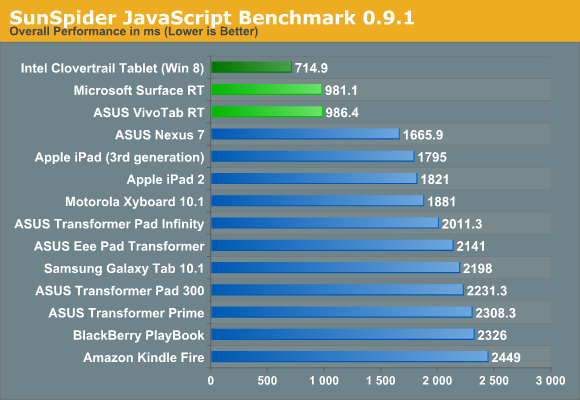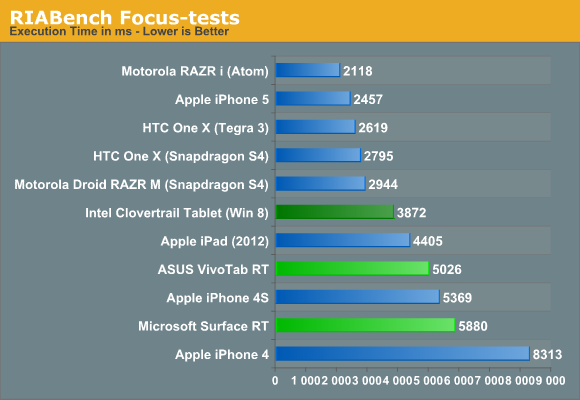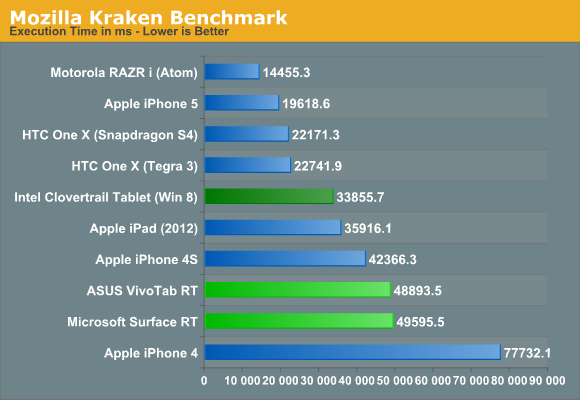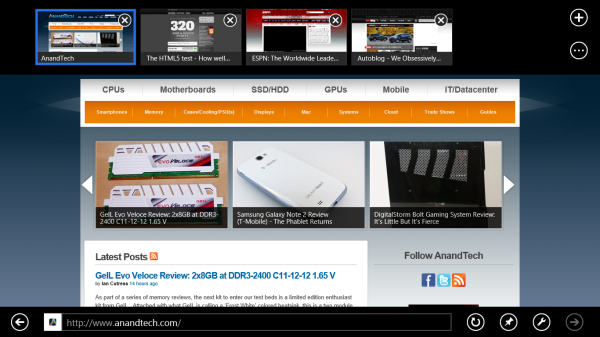The Windows RT Review
by Vivek Gowri & Anand Lal Shimpi on October 25, 2012 12:00 PM EST- Posted in
- Windows RT
- Operating Systems
- Microsoft
- Mobile
- Windows 8
- Tablets
Internet Explorer 10
There are two distinct versions of Internet Explorer 10 - one that runs in the desktop and looks very similar to the IE9 and IE10 experiences that we’ve been used to on the Windows 7/Windows 8 desktop, and another that runs within the framework of Modern UI and looks like an upscaled version of IE9 Mobile from Windows Phone 7.5 Mango. Both use the same rendering engine and perform identically, so we’ll keep that in mind when looking at performance numbers. Other than the user interfaces, there’s relatively little difference between the two browsers, though you will need to open the desktop IE10 to change browser settings - there's no way to do so from within Modern UI.
Gestures in the Modern UI version of IE are very important - swiping from the top or bottom brings up the URL bar at the bottom and the thumbnail list of open tabs at the top. It looks great, and keeps the webpage completely clean, but I don’t think the tabbed browsing implementation here is that great - I’d rather see something like Chrome or Safari with the list of open tabs always displayed at the top of the window. Changing tabs requires an extra step (swipe, then select), which isn’t ideal for changing between tabs quickly. If you deal with a lot of open tabs, or have some need to flip between two specific tabs repeatedly, this will get annoying relatively swiftly. It still looks great, and for touch-based browsing it works quite well other than the concerns over tabbed browsing. The “fancy” version of IE10, as Anand called it, strikes me as a very idealistic design philosophy that doesn’t necessarily work as well as a less elegant interface might.
One feature that works very well but could use some performance tuning is the back/forward touch navigation for Modern UI's IE10. To go back a page just swipe from left to right (or right to left to go forward). It's incredibly intuitive. My only complaint? Although going back immediately shows you the previous page, you have to wait for the page to actually re-render before it's usable (which on present day ARM hardware isn't exactly fast). I suspect this is something that will become far more useful over time with faster SoCs.
The desktop IE10 is just desktop IE, you’ve seen this before. Nothing that new, the UI looks pretty similar to IE9 (which is the first version of IE I can remember enjoying, though it will never replace Chrome in my heart) and it functions similarly as well. Obviously, there’s an updated rendering engine, but other than that and a new scrollbar design to match the rest of the Modern UI visual style, there’s not much to see here.

The most interesting part, actually, is in the settings - you can set links to default open in Fancy IE10, the desktop IE10, or let IE decide which to use on a contextual basis. You can also have the IE10 tile in Modern UI to open the desktop IE10, so you can basically ignore the new IE10 UI entirely should you want to do so. Now, I suspect this option exists primarily for desktop and notebook users of Windows 8, who don’t want to deal with using the Fancy IE10 interface with a mouse input. But it’s there for Windows RT users who want to use only the desktop IE10 UI. Personally, I wouldn’t want to use the classic interface in touchscreen devices - UI elements are damn small at this pixel density, making it more difficult to hit the right buttons than it needs to be. There’s a reason the Modern UI variant of IE10 exists.
Performance



From a performance standpoint, we’ve just brought over the same three benchmarks that were used in the VivoTab RT and Surface RT reviews - SunSpider, RIABench, and Mozilla's Kraken. Honestly, I think SunSpider scores are becoming irrelevant - as one of our commenters said, the art of getting better SunSpider scores has started becoming a race to see who can cheat on the test most. Cheating in this case would be considered optimizing browsers for this specific test, and they’re not wrong. While IE10 has great, great SunSpider scores, it’s far behind in the other two JS benchmarks compared to similar hardware running on other platforms - look at the Surface or VivoTab RT compared to the international Tegra 3 version of the HTC One X. And I’m almost certain that if we had a Nexus 7 on hand to run those tests on, the differences would be larger still.
The HTML5 Test score 320 (plus 6 bonus points) is better than most tablet browsers from a year ago, but lags behind the latest mobile versions of Safari (386+9) and Chrome (390+11). Our Windows 8 Consumer Preview article showed that IE10 had made some pretty significant strides from IE9 (which was leaps and bounds better than 8, and then some) but JS performance is still behind the curve for now. The experience doesn’t suffer from that though - it’s still a very capable modern browser that won’t leave you disappointed.











233 Comments
View All Comments
taltamir - Friday, October 26, 2012 - link
Good observation.Being impartial I have to say I am applying the argument fairly to both sides.
I held that Windows v Mac has windows as the clear winner due to sheer amount of software.
And the iOS is clearly superior to Window (singular) Metro for the same reason.
PeteH - Thursday, October 25, 2012 - link
No one's going to install 10s of thousands of apps, but if you want an app with a specific feature that doesn't have wide appeal you might not find it unless the ecosystem you're using has 10s of thousands of apps to choose from.StormyParis - Thursday, October 25, 2012 - link
You're confusing depth and breadth. 10,000 fart apps does not mean there *has* to be 1 medical clinic management app, 100,000 10 .. etc etc. I would assume the vertical market devs that most probably already have Windows apps, maybe even XP for Tablet apps, will be rather quick to port them not only to Win8, but to Metro. It will certainly not take a month though, probably more like a year or two, and MS need to prove quickly they can sell their stuff.PeteH - Thursday, October 25, 2012 - link
No, I'm saying that the fewer apps a platform has, the less likely it is that the platform will have an app with a smaller target audience. It's the classic long tail argument, when there are only a small number of apps they will focus on the fatter head.Also, I'm not speaking of any platform specifically, just as a general rule.
Stuka87 - Thursday, October 25, 2012 - link
If you are making reference to the iOS App store, to say most of them are "fart and flashlight" apps is incredibly naive. Sure there are apps that are very basic and/or useless/pointless. But to say they are the majority is laughable.And does any one person install them all? Of course not. But not everybody has the same wants or needs. So it takes a large pool of apps to make everybody happy.
It will be quite some time before the MS store gets enough apps to have the same coverage. I too think a month is being overly ambitious.
StormyParis - Thursday, October 25, 2012 - link
There was that bit last moth about 75% of apps not having been downloaded even once ?PeteH - Friday, October 26, 2012 - link
I hadn't seen that story, so I looked it up. It was an estimate by an outside agency (not official numbers), and was 60%, but that's still eye opening.Although thinking about it, is it really surprising? The more apps available the more crappy apps (or crapps, if you will) available. I would assume such a relationship is common across platforms, at least once some threshold is reached.
What would be really interesting would be a breakdown of those apps. How many were free vs. paid? Of the paid apps, what is the distribution across price?
extra_medium - Saturday, October 27, 2012 - link
Laughable? Are you serious? Of course the majority of apps are pointless / crap. Do you really think over 350k of the 700k plus apps available to iOS users are high quality?Also not surprised at the 60% - 75% of apps never being used estimates. With the sheer volume available I'm actually surprised that number isn't higher. The average user isn't going to dig to find undiscovered gems. They are going to look at top sellers, listen to Leo laporte, and see what their friends use.
I do agree with the argument though that a huge marketplace is advantageous. Even if the vast majority is pointless, there are more of those gems out there.
Dekker - Thursday, October 25, 2012 - link
I think that the pricing of the apps is going to be crucial. If the Windows RT apps are all $10-20 (like the Mac AppStore) then that kills impulse buying and they are not going to be nearly as popular as the IOS apps (typically $1-3). Windows RT will then suffer as a consequence.As mentioned by others this is a platform war and starting a virtuous circle in software development is very tough at this stage of the Tablet market. That is particularly so if developers are targeting the corporate market, which is only a fraction of the consumer market for Tablets.
a5cent - Thursday, October 25, 2012 - link
A good piece of software is certainly worth $10 - $20! People go to the cinema for that price too, right?A software title that is targeted at impulse buyers, isn't likely to be even worth $1. We don't need 100's of thousands of apps, we need a couple thousand really really good ones and if they cost a bit more that is absolutely fine by me. I'll take quality over quantity anytime.